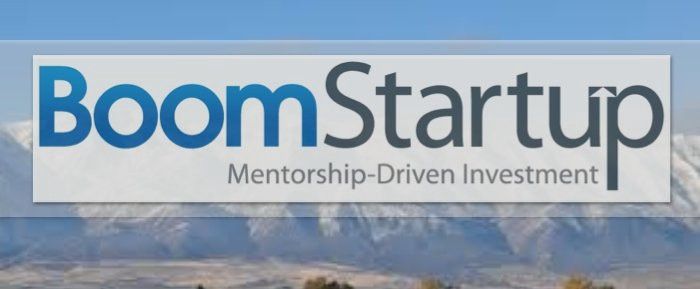We’re getting acknowledged by people from outside of Utah that we can produce some kick butt companies.
Robb Kunz started his career as a software developer, building foreign exchange arbitrage systems for some of the largest banks in the world. He’s lived in London, Paris, Kuala Lumpur (Google it), Sydney, and probably 15 other cool places you wish you could visit someday.
“I spent 10 years of my career working around the world with the largest money center capitals of the world,” Kunz said in a recent interview with Beehive Startups at BoomStartup’s headquarters in Salt Lake City.
“I’d move to the money center bank, and I had made a name for myself and was known in the global ecosystem. I was the guy to be doing big banking; these are $100 million projects, 180 people on a team. Bring a team in, recruit, I’d build it up, and then I would sell that company. I’d leave the country and go to the next money center bank and then basically sell that company, so I had a number of multiple mini exits.”
According to renowned philosopher and musician Ingrid Michaelson, there are just three things a person should do once they get rich:
1. Buy your parents homes in the south of France.
2. Give everybody nice sweaters and teach them how to dance.
3. Build a house on a mountain, making everybody look like ants.
Imagine our surpise when we learned Kunz chose to do none of those things after he was able to put a little bit of money in the bank (can we at least get a nice sweater, Robb?).
“When I came back to the United States I thought, ‘Now what am I doing to do?’” said Kunz.
What he did was build a $100 million security practice for Unisys Corporation, a Fortune 500 company based in Salt Lake City. He did that for eight years, but eventually decided the corporate life was no longer his scene.
“I’ll never retire. I love doing this stuff, and really wanted to merge my big Fortune 500 global knowledge with my tech knowledge, with my investment-financial services knowledge, and really focus more on putting angel investment, early stage startups, and early stage investments into the entrepreneur community ecosystem. I got active in angel investing, and then five years ago launched BoomStartup with John Richards as a partner,” said Kunz.
To the betterment of Utah’s startup community, Kunz decided to help local startups find traction, get capital, and become successful, rather than following Ingrid Michaelson’s impractical, yet appealing advice.
A Top Tier Accelerator Right Here In Utah
BoomStartup was recently named one of the top 15 accelerators in the United States, as first reported by TechCrunch.
“There’s a trend happening here, and I think it’s an exciting trend,” said Kunz. “I think it helps our ecosystem. We’re getting acknowledged by people from outside of Utah that we can produce some kick butt companies.”
The success of an accelerator is, for the most part, judged by the number of startups funded, sustainability, revenue and earnings growth, exits, and shareholder value. By those metrics, Kunz believes BoomStartup stacks up with the best accelerators in the country.
“We just finished our fourth year last year. We have gotten 65% of our companies funded, so that means we’re right in line…Techstars is 72%, 74% so we’re right in line with what I want to call the ‘tier A accelerators’ in the United States. That’s a good thing. We’re performing consistently year after year. Our sustainability metric is about…78%, I think is the actual number. So 78% of our companies in the last three years that we funded are still operational and going. Those are really the two big metrics, and we’re right up there with all the big names,” said Kunz.
According to most studies on the topic, the average age of an acquired startup is seven years. BoomStartup has only been around for five years, which makes it difficult to judge the accelerator by its exit numbers.
“We’ve just started our fifth year, so in the next couple years you should start to see this harvesting of some of those early companies. And maybe even earlier; we’ve got a couple this year, one particularly that looks fairly good, maybe this summer. If we do that I think that will be the final checkpoint for us,” said Kunz.
For its Summer 2014 class, BoomStartup will be accepting up to 10 startups to join its Salt Lake City campus, and up to five startups to join the campus based in Provo. The program lasts 13 weeks, beginning May 12th and running through August 8th. Applications are still open for the Summer 2014 class.
Let’s Get You Funded
While covering the startup scene here in Utah, we’re often asked about the BoomStartup program and whether it’s a worthwhile option to help get a startup off the ground. The one recurring question we’re asked is: “Does BoomStartup pressure their companies to try to get funded on Demo Day?” It’s unclear why we continue to get asked this question, but we posed it to Kunz to help the community better understand the role of an accelerator.
“First of all, if our key metric is to get companies funded then by its nature the culture of the thing is going to be getting ready for Demo Day and get funded,” said Kunz. “Most of the time when we do the pre-selection process and interview, we usually target select companies that want to get funded. Sometimes what we’ve found is most people come to the program wanting to get funded, they get halfway through the program and they go through this thing we call ‘mentor whiplash’ which is very intense, real discussions about your model and we find a lot of the companies draw back. ‘Wow. Maybe I have a company that can’t get funded.’ Our analysis after the program is a lot of those companies that do that maybe weren’t really ready for funding and it’s almost easier for them to say, ‘We’re not going to raise funding,’ and just not do anything. I think there’s a theme definitely, and it’s part of our selection criteria, and it’s what we’re really all about. That’s where we add a lot of value.
“Our philosophy at BoomStartup is to propel the entrepreneur so if you don’t want to get funding, you don’t need to get funding. But there’s one thing: you’ve already had investors in BoomStartup that gave you initial seed funding to invest in you. So you have a little bit of an obligation already. If you’re not going to get funding that’s great, but I hope you’ve got revenue traction, or an alternative plan to do that because you already have investors invested in you.
“When you take funding, at least from my opinion when I took funding, there’s some responsibility back to your investors for the most part. To a certain extent, I think that’s only fair. If not and you don’t want to get funding, you should give the investors their money back and go do your own thing. Maybe it took going through BoomStartup to do that, but I think there’s a two-way street there.”
The Selection Process
We wanted to better understand the type of companies and entrepreneurs BoomStartup would like to apply to their program. Here’s what Kunz told us:
I’ll give you some key selection criteria that we look at. The first thing is when you look at these applications our selection criteria is based in thirds. If you think of a life cycle, think of this as company maturity. A third of our companies we want to have revenue somewhere between $10,000 in revenue to $2 million. We’ve had a couple companies in the $1,000-plus range. We find anything more than $2 million it gets a little bit controversial with the equity that we want — they think they’re too late stage is really part of the problem. That’s not always the case, by the way. You’ve got to have revenue: $10,000 to a million or $2 million. A third of the companies we’re selecting on that basis.
The next third is we want you to have a validated minimum viable product. You have product validation with customers, and you’ve proven that the customers will pay. Even if it’s only $500 bucks, we don’t care. There’s a big fence between will that customer pay that $1 or $10. We don’t care; if it’s $500 or $10,000 — that to us is product validation. Customers: that’s one third.
The other third are companies that have done business model validation, they’ve got a solid business plan, they’ve done customer validation, they can show us customer lists and we can call those lists, they built a prototype. Maybe not a full minimum viable product, but some type of prototype that proves that they can create something of value and they have gotten customer engagement in using that, nowhere near paying for it — just using it. It’s a usability-engagement level.
Those are the one third, one third, one third buckets. If we do 10 companies it’s three, three, four. Or three, four, three. We want to do a spread so there are a couple things. Remember investors in the community are backing the BoomStartup program, so from an investor perspective it provides portfolio diversification doing the one third, one third, one third. We’ll bet some early stage, some later stage, and some in the middle, so it’s fair to the investors to do that. But also we find when we put the cohorts together there’s a lot of peer-to-peer mentoring. One of the things we facilitate is this huge peer-to-peer mentoring that happens. I think bringing in a company that’s done revenue and they can help this company over here that just has minimum viable product: ‘I was in your shoes a year ago. Let me tell you what I did.’ We found by mixing up those one third, one third, one third it just brings enormous value and energy to those companies. That’s part of the model as well, and why we do that from a selection perspective.
After reviewing more than 700 applicants for our Summer 2014 Program, Utah needs several more accelerators to better service our ecosystem!
*— Robb Kunz (@robbkunz) *April 9, 2014
It Takes Two To Make A Thing Go Right
Part of BoomStartup’s criteria for selecting startups is only accepting companies with two or more co-founders to join the program. Like most accelerators, BoomStartup believes the odds of a startup’s success dramatically increases if it has more than one founder.
If you’re a business developer, you should partner with a software developer. If you’re a software developer, you’re going to be just fine, throughout your career and life — no matter what happens at BoomStartup, honestly — but you’re still going to want to partner with a business guy just in case your company ever needs to talk to and interact with other human beings (< / lame stereotype joke >).
“You really need the biz guy and the tech guy; it’s two different chemistries, it’s two different dynamics, it’s two different sets of expertise, and so being a solo founder is really, really difficult and your chance of success is so much higher with two,” said Kunz.
Interestingly enough, in our interview Kunz revealed 18% of BoomStartup’s teams will experience some type of break up either during the program, or within three months of graduation.
“You get a biz guy that has a great idea; he just finds a tech guy, and he gets a tech guy because he has to have a tech guy. And maybe because the chemistry’s not there, the passion for the thing’s not there, and so what happens is over three or four months of working together you get the founder clash,” said Kunz. “Trying to force people together is really delicate. It’s like any relationship. One of the things you’ll see if you ever sit through one of our interviews with the companies is one of the first things we do is we always go into the deep dive of how did you meet, how long have you been together?
“A company that just pitched us yesterday: grade school friends, do everything together, learned to fly, all this stuff together, said, ‘We’re going to build a company together. We split and went our own ways and worked for other people and now we’ve come back together.’ That chemistry between them, how they split, went off on their own, they’re going to do this together just like they learned hang gliding and flying and everything else. That’s the kind of founding team that we like because they’re going to have strength and foundation. That’s a really important due diligence question and dialogue when we’re looking at what founder attributes are.”
“Sweat Equity Is The Best Equity There Is.” — Mark Cuban
The other two questions we’re most often asked when talking to budding entrepreneurs about BoomStartup is: 1) How much equity will they take in my company? 2) How much money will they invest in my company?
If you’re accepted into the program, BoomStartup will invest $20,000 in your company and take a 6% equity stake.
“We take 6% common equity,” said Kunz. “Not preferred equity like most investing firms. Common equity is like founders; we’re like a founder on the stock cap table. They have common shares, we have common shares.
“On Demo Day, when the Demo Day investors invest, they get preferred shares which means they get paid back first. It’s a common stake of 6% for that $20,000 cash infusion we give, plus the quarter of a million value-in-kind services.
“Rack Space gives us $24,000, PayPal gives us $10,000. Open up a PayPal account the first day of the program, they put $10,000 of credits in it. They get that quarter of a million investment on top, which is really good because they don’t need to take their money that investors are giving them and pay for all the operational expenses that any company is going to have: legal fees, accounting, advertising, taxes, everything you need to do to run a company is all in that quarter of a million chunk, basically. It really gives them like a year to essentially figure out the plan.”
“Be yourself; everyone else is already taken.” — Oscar Wilde
Kunz is originally from Minnesota. When he came back to the United States after 10 years of working overseas, he had the option of moving to any city in the United States. He had three main requirements when it came to choosing his next city: “an airport within 20 minutes, my house could back up to a wilderness area, and it had to be big enough where there were some good restaurants and some night life.”
“When I looked around the United States and went to all the places it was amazing that when you look at those three attributes, Salt Lake is one of the only places you can really get all that,” said Kunz.
Kunz believes Utah should be touting what makes this state such a unique place to live, play, and start a business.
“I think we should stand on our own,” said Kunz. “I’ve actually never liked the name ‘Silicon Slopes.’ Right or wrong, we’re not Silicon Valley. We’re not. We are Utah, and we have our own ecosystem, our own brand, and we’re creating that. We’re a little bit younger, but we’re creating that. I always think we’re about us. It’s not about trying to be someone else, and I think that’s what makes us different. And I think we have a lot that’s different compared to these other places.”
Show Me The Money
In the early stages of building a company, Utah entrepreneurs shouldn’t worry too much about the lack — or at least the perceived lack — of venture capital in the state. If you build a great product and company, the money will be there when the time comes.
At some point, though, Utah startups are going to need to raise money. We asked Kunz to give us his take on the venture capital ecosystem here in Utah, and whether we should be doing more to attract firms to this state.
“We need to attract more, there’s no question,” said Kunz. “I want to say there’s still a shortfall in angel capital here in the state of Utah. There are not enough guys writing checks.
“The second thing is, in the big picture, in the industry, venture capital firms have gone from 1,600 firms down to 700 or 800. There’s been a rapid decline in venture capital across the United States; why the seed and angel has gone up, basically. Here in Utah we’ve really suffered. We still have a few firms, but those firms, in my opinion, aren’t doing early stage investing in Utah. They’re investing outside of Utah.
“I would say we still have an issue with getting more venture capital, and I think you’re going to see, just in the next year, you’re going to see more funds and larger funds, but still not adequate to serve the ecosystem. I think we’re still going to see a lot of our companies go outside of the state for capital.
“There are good and bad to that. From an entrepreneur perspective, you get higher valuation when you go out of state. If you can get out-of-state capital, you get a high valuation, you get a national and sometimes global, international brand depending on who you get the capital from. My basis is always back to the entrepreneur: I think that’s okay. Do I want to see those companies stay here and create jobs? Yes. But if it’s the right thing for the company, I’m betting we’re going to get a second order effect. When those guys get their exits, they’re going to come back to Utah and start 20 more companies that take off. That would be my bet, and time will tell us if that really happens or not.”
“Diversity … is the cornerstone of progress, as I’ve always said.” — Michael Scott
Bringing more diversity into the tech world is something every city in the United States is struggling to make happen. Kunz believes it’s vital to Utah’s long-term success.
“I think bringing diversity into the state is a really important thing because you build better companies, build better ecosystems, you get different ideas,” said Kunz.
“Diversity is good and healthy. I think if we all just understand diversity is a good thing, let’s embrace diversity, but still let’s collaborate and cross-communicate, and not be confrontational about A versus B. I’m hoping that that’s where all my energy is going in building a better ecosystem is the cross connection of that. And probably, hopefully, some leadership around that as well.”
![]()
Under Kunz’s leadership, BoomStartup has become an integral part of Utah’s startup ecosystem. The Beehive State’s most prominent accelerator has the ability to connect earnest entrepreneurs to the brightest and most capable minds, not only throughout Utah, but throughout the country.
If you’re building a startup here in Utah, and you’re looking to take it to the next level, at the very least you should set up an appointment to talk to Robb Kunz. No matter what happens after that meeting, you’ll have been mentored by one of the finest entrepreneurial minds in the state.
Published 4/10/2014






